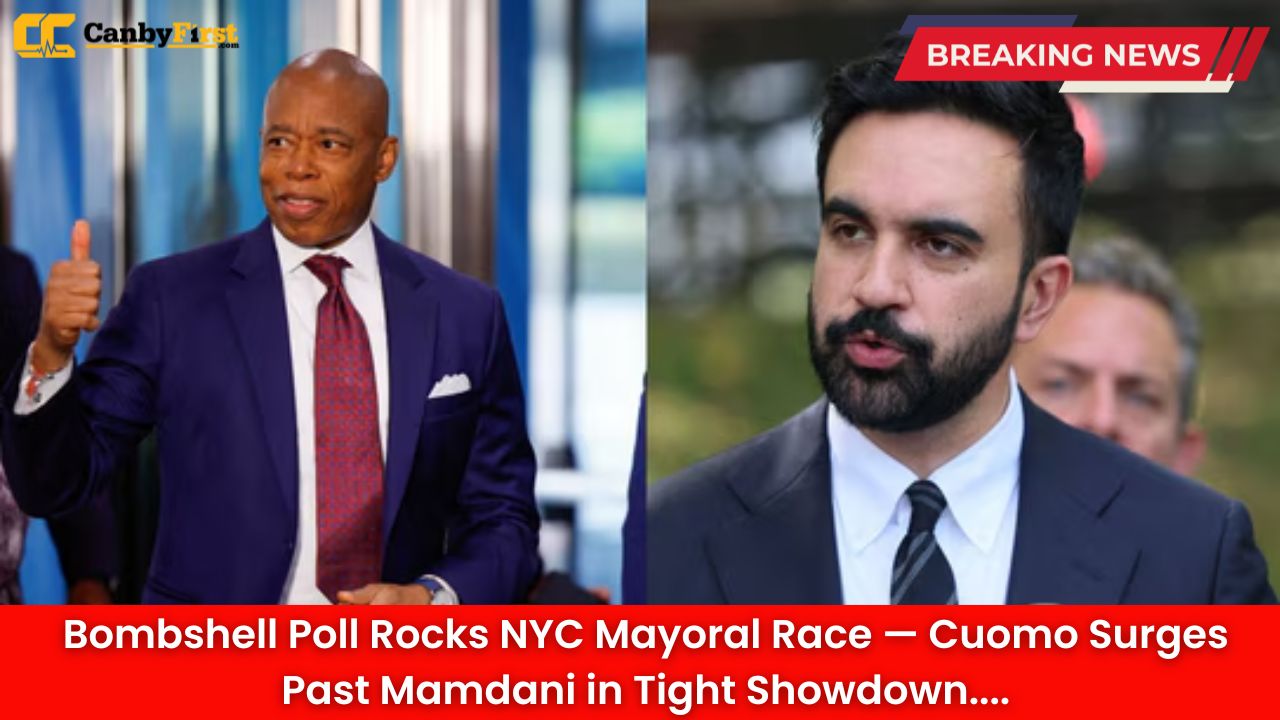New York, US: A new bombshell poll has sent shockwaves through New York City’s political circles, revealing that former Governor Andrew Cuomo has taken a narrow but commanding lead over Congressman Zohran Mamdani in a hypothetical one-on-one matchup for mayor. The survey, conducted just months before the official campaign season heats up, signals a stunning potential comeback for Cuomo and fresh challenges for Mamdani’s insurgent progressive movement.
According to the poll, Cuomo leads Mamdani by seven percentage points (48% to 41%), with 11% of voters still undecided. The results mark the first major indication that the city’s Democratic electorate may be shifting toward a more centrist candidate after years of progressive dominance under current Mayor Eric Adams.
Cuomo’s Political Resurrection
Cuomo’s emergence in the race marks a remarkable turnaround for the former three-term governor, who resigned in 2021 amid controversy. In recent months, Cuomo has gradually reentered the public conversation — appearing on talk shows, attending community events, and quietly building a coalition of moderate Democrats, law enforcement groups, and business leaders disenchanted with City Hall’s direction.
Also Read
Political strategists note that Cuomo’s name recognition, administrative experience, and tough-on-crime reputation appear to be resonating with New Yorkers fatigued by public safety concerns and economic uncertainty.
“Andrew Cuomo represents stability and experience at a time when New York feels adrift,” said one Democratic political consultant. “He’s benefiting from a perception that his leadership style, though polarizing, gets results.”
Mamdani Faces Mounting Headwinds
For Zohran Mamdani, the upstart Democratic Socialist from Queens, the poll represents a critical warning sign. A rising progressive star known for his advocacy on housing justice, public transit, and wealth redistribution, Mamdani had been seen as the early favorite in a fragmented Democratic field. But in a one-on-one race against Cuomo, the numbers suggest his movement struggles to expand beyond its activist base.
Analysts point to Mamdani’s younger, left-leaning coalition as both a strength and a limitation. While his agenda excites progressive voters, it faces skepticism among older, middle-class, and outer-borough voters — groups that turn out reliably in municipal elections.
“Mamdani’s challenge is converting energy into trust,” said Dr. Harold Stein, a political science professor at NYU. “New Yorkers may agree with his ideas, but many are unsure if his movement can deliver practical solutions on crime, cost of living, and governance.”
Divided Party, Divided City
The race underscores a deep ideological divide within New York’s Democratic Party. Progressive leaders have rallied behind Mamdani, framing his campaign as a generational movement to transform the city’s economic and political systems. Meanwhile, moderates and centrist Democrats view Cuomo’s comeback as a pragmatic bid to restore order and managerial competence.
Party insiders are reportedly alarmed by the poll’s implications. A close Cuomo-Mamdani race could exacerbate internal fractures and complicate the Democrats’ overall strategy to maintain unity ahead of next year’s primary.
“Cuomo and Mamdani represent two entirely different visions for New York,” said one senior party operative. “Whoever wins will define the soul of the Democratic Party in the city for the next decade.”
Key Issues Driving the Race
Polling data reveals that public safety remains the top concern among voters, followed by housing affordability, public transportation, and government transparency. Cuomo enjoys wide support on safety and public administration, while Mamdani dominates on housing reform and social equity.
| Issue | Cuomo Support Lead | Mamdani Support Lead |
|---|---|---|
| Public Safety | +22% | — |
| Housing Affordability | — | +18% |
| Economic Equity | — | +12% |
| City Management | +15% | — |
This divide suggests the campaign could hinge on which candidate manages to broaden their appeal beyond their core base. For Cuomo, softening his image with younger voters and progressives will be key. For Mamdani, demonstrating practical leadership on day-to-day city issues could prove decisive.
Cuomo’s Comeback Strategy
Sources close to Cuomo say he is preparing a “listening tour” across the five boroughs to reintroduce himself as a pragmatic problem-solver rather than a combative executive. The former governor is expected to emphasize his record on infrastructure, pandemic management, and fiscal responsibility — while also pledging to modernize government transparency and ethics protocols.
His campaign team is reportedly testing the slogan “Experience That Works”, aimed at voters who crave stability and competence after years of turbulent city politics.
Mamdani’s Progressive Push
Mamdani’s campaign, meanwhile, is planning to double down on its grassroots energy. His team intends to mobilize thousands of volunteers to canvass working-class neighborhoods, advocate for tenant protections, and promote a vision of a “New York for All.”
In recent speeches, Mamdani has framed the race as a stark choice between “the politics of the past” and “the promise of a people-powered future.” His campaign emphasizes that Cuomo’s tenure was marked by entrenched power and corporate influence — themes likely to galvanize progressive voters.
Voter Sentiment and the Road Ahead
The poll offers a snapshot rather than a prediction, but the numbers suggest a highly volatile contest ahead. In a city of more than 3 million registered Democrats, turnout and momentum can swing dramatically in the final months leading to a primary.
Cuomo’s advantage may reflect nostalgia for decisive governance, but Mamdani’s social media-savvy and youth-driven movement remain potent forces. Independent voters, though not decisive in a Democratic primary, could also help shape the narrative heading into the general election.
If the field remains crowded, with other potential contenders like Public Advocate Jumaane Williams or Comptroller Brad Lander entering, both Cuomo and Mamdani could face complex coalition puzzles — potentially leading to unpredictable outcomes.
What’s Next for New York Politics
The emergence of Cuomo versus Mamdani as a defining political showdown could reshape the city’s ideological balance for years. A Cuomo victory would mark a return to establishment politics and signal a broader national backlash against progressive governance in large cities. A Mamdani win, meanwhile, would consolidate New York as a flagship for the left’s urban policy vision.
With the first major debates expected early next year, all eyes are now fixed on how both men navigate an electorate torn between progressive idealism and pragmatic governance.
FAQ
Who conducted the poll?
The poll was conducted by a nonpartisan public opinion firm specializing in municipal elections. Specific methodology details were not released publicly but are reportedly based on a representative sample of likely Democratic primary voters.
When is the NYC mayoral election?
The Democratic primary will take place in June 2026, followed by the general election in November 2026.
Could Andrew Cuomo actually run?
While Cuomo has not formally declared his candidacy, his recent media appearances, policy speeches, and fundraising activity strongly suggest he is exploring a potential bid.
What are Zohran Mamdani’s main campaign focuses?
Mamdani is centering his campaign on housing justice, public transit improvements, climate action, and wealth redistribution to benefit working-class New Yorkers.
What’s at stake in this race?
Beyond deciding the next mayor, the outcome will shape New York City’s political identity — determining whether it continues down a progressive path or pivots back toward centrist governance.












